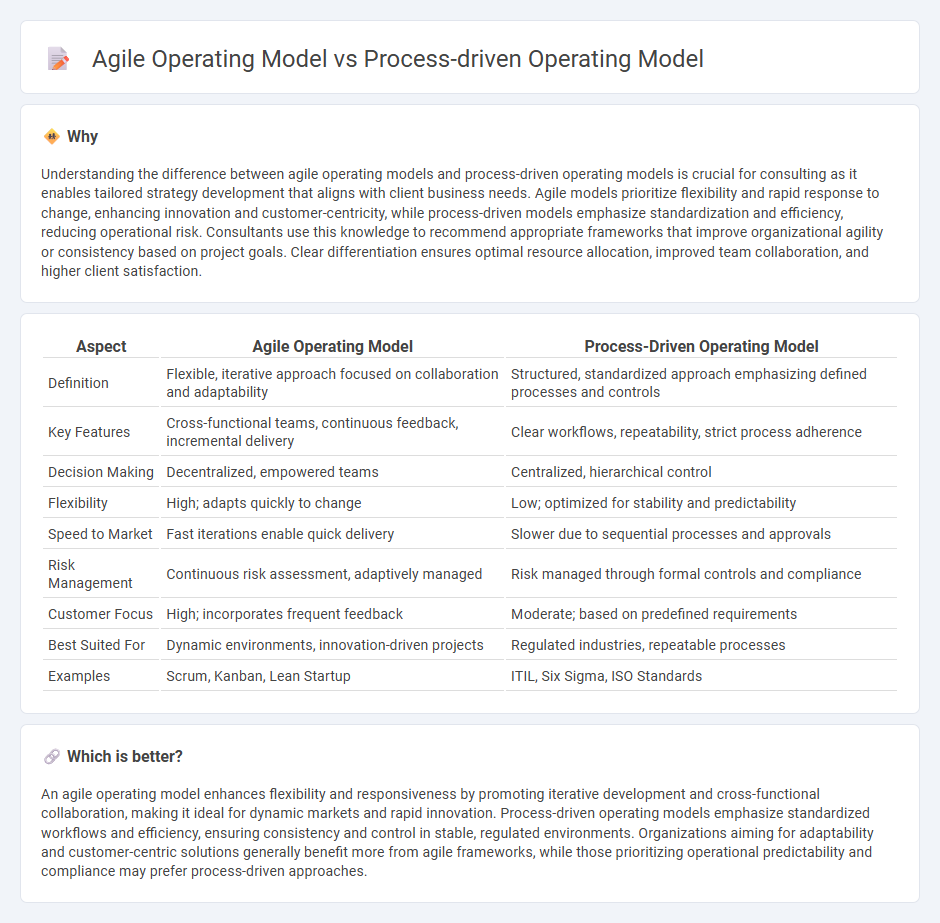
An agile operating model emphasizes flexibility, iterative progress, and rapid response to change, fostering continuous improvement and customer-centricity in consulting projects. In contrast, a process-driven operating model relies on standardized procedures and well-defined workflows, ensuring consistency, scalability, and risk mitigation across engagements. Discover how choosing the right operating model can transform your consulting outcomes.
Why it is important
Understanding the difference between agile operating models and process-driven operating models is crucial for consulting as it enables tailored strategy development that aligns with client business needs. Agile models prioritize flexibility and rapid response to change, enhancing innovation and customer-centricity, while process-driven models emphasize standardization and efficiency, reducing operational risk. Consultants use this knowledge to recommend appropriate frameworks that improve organizational agility or consistency based on project goals. Clear differentiation ensures optimal resource allocation, improved team collaboration, and higher client satisfaction.
Comparison Table
| Aspect | Agile Operating Model | Process-Driven Operating Model |
|---|---|---|
| Definition | Flexible, iterative approach focused on collaboration and adaptability | Structured, standardized approach emphasizing defined processes and controls |
| Key Features | Cross-functional teams, continuous feedback, incremental delivery | Clear workflows, repeatability, strict process adherence |
| Decision Making | Decentralized, empowered teams | Centralized, hierarchical control |
| Flexibility | High; adapts quickly to change | Low; optimized for stability and predictability |
| Speed to Market | Fast iterations enable quick delivery | Slower due to sequential processes and approvals |
| Risk Management | Continuous risk assessment, adaptively managed | Risk managed through formal controls and compliance |
| Customer Focus | High; incorporates frequent feedback | Moderate; based on predefined requirements |
| Best Suited For | Dynamic environments, innovation-driven projects | Regulated industries, repeatable processes |
| Examples | Scrum, Kanban, Lean Startup | ITIL, Six Sigma, ISO Standards |
Which is better?
An agile operating model enhances flexibility and responsiveness by promoting iterative development and cross-functional collaboration, making it ideal for dynamic markets and rapid innovation. Process-driven operating models emphasize standardized workflows and efficiency, ensuring consistency and control in stable, regulated environments. Organizations aiming for adaptability and customer-centric solutions generally benefit more from agile frameworks, while those prioritizing operational predictability and compliance may prefer process-driven approaches.
Connection
The agile operating model and process-driven operating model are interconnected through their emphasis on efficiency and continuous improvement in consulting practices. Agile frameworks prioritize flexibility and iterative progress, while process-driven models focus on standardized workflows to ensure consistency and quality. Combining these approaches enables consulting firms to adapt rapidly to client needs while maintaining structured, repeatable processes that drive operational excellence.
Key Terms
Standardization
Process-driven operating models emphasize standardization by implementing defined workflows and consistent procedures to enhance predictability and efficiency across the organization. Agile operating models prioritize flexibility and adaptability, often balancing standardization with iterative processes to respond swiftly to change. Explore more to understand how each model affects operational performance and scalability.
Flexibility
A process-driven operating model emphasizes standardized procedures to ensure consistency and predictability, supporting scalability in structured environments. In contrast, an agile operating model prioritizes flexibility and rapid adaptation to change, enabling organizations to respond swiftly to market dynamics and customer needs. Explore how each model impacts business agility and operational efficiency to determine the best fit for your organization's goals.
Continuous Improvement
The process-driven operating model emphasizes standardized workflows and consistent process optimization to enhance operational efficiency, while the agile operating model prioritizes flexibility and iterative development to respond rapidly to change. Continuous improvement in a process-driven model relies heavily on structured methodologies such as Six Sigma and Lean, whereas agile leverages frequent feedback loops and cross-functional collaboration to refine work deliverables. Explore in-depth comparisons and best practices to determine which model best supports continuous improvement in your organization.
Source and External Links
Process Driven Architecture And Why It's Important - FlowWright - A process-driven operating model centers software design and implementation around business processes, enabling efficiency, adaptability, and automation of routine tasks for improved operational effectiveness.
Why a Process-Driven Approach is Essential for Business Efficiency - A process-driven operating model uses structured systems and automation to ensure consistent, scalable workflows, reducing reliance on people and improving productivity across business functions.
Transitioning from a People-Driven to Process-Driven Organisation - This model emphasizes documented, standardized workflows for consistency, efficiency, and knowledge retention, contrasting with the variability and risks of people-dependent operations.
 dowidth.com
dowidth.com